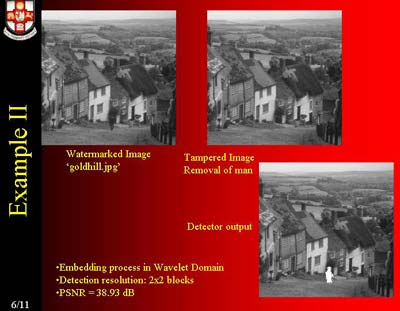Hi-tech ‘watermark’ will expose digital images that have been tampered with

Digital images that have been tampered with could now be spotted – thanks to a digital ‘watermark’ developed by UK scientists
Digital images such as CCTV footage are increasingly being used as evidence in high profile court cases. However, it is easy to tamper with an image and very difficult to tell if any manipulation has taken place.
Researchers have created a digital version of a watermark to tackle this problem and validate digital evidence. The team is led by Professor Dave Bull at the University of Bristol and funded by the Swindon based Engineering and Physical Sciences Research Council.
The watermark will appear on the images – either still or video- and track any changes made to the original version.
Professor Bull said: “With a hi-tech problem, we needed a hi-tech solution, but drew our inspiration from the humble paper watermarks first created in the 18th century”.
Professor Bull’s team’s version of the centuries old ‘watermark’ works by creating an electronic seal around the image in its original state. The watermark is applied automatically at the point when the image is taken by incorporating appropriate software into the camera. Encoded information within the watermark will show if it is subsequently tampered with.
“The idea is that if the image file is passed through a special statistical detector it will be able to read the digital watermark and detect if the image has been attacked. It will also show how the image has been amended – for example the hands on a clock might have been changed to show a different time, or a face might have been obscured,” says Professor Bull.
Professor Bull hopes his team’s research will be adopted by digital film and camera manufacturers and applied as part of an industry-wide security standard.
The watermark uses patent-pending technology, which is based on the use of mathematical algorithms
Media Contact
All latest news from the category: Information Technology
Here you can find a summary of innovations in the fields of information and data processing and up-to-date developments on IT equipment and hardware.
This area covers topics such as IT services, IT architectures, IT management and telecommunications.
Newest articles

First-of-its-kind study uses remote sensing to monitor plastic debris in rivers and lakes
Remote sensing creates a cost-effective solution to monitoring plastic pollution. A first-of-its-kind study from researchers at the University of Minnesota Twin Cities shows how remote sensing can help monitor and…

Laser-based artificial neuron mimics nerve cell functions at lightning speed
With a processing speed a billion times faster than nature, chip-based laser neuron could help advance AI tasks such as pattern recognition and sequence prediction. Researchers have developed a laser-based…

Optimising the processing of plastic waste
Just one look in the yellow bin reveals a colourful jumble of different types of plastic. However, the purer and more uniform plastic waste is, the easier it is to…



